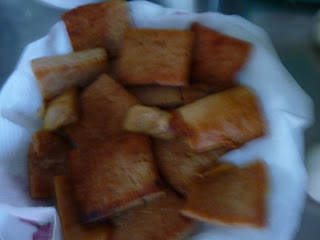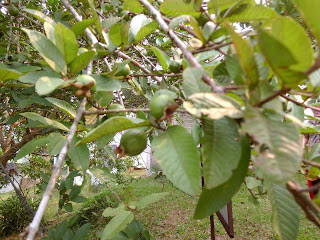It seemed to be bad timing to go in the open with the hazy weather hovering to the dangerous level but this trip has been planned before the haze swept in. According to the organiser, if not for the haze this is an idyllic place to escape to de-stress, de-toxify and rejuvenate your body and mind and to attune your body with nature again.
Once again I have joined Mr. Wong of the Meetup group and together with his group of students from the RPA Holistic Wellness Academy for this field trip.
Mr. Wong explaining to us on what is organic farming.
According to him, to be certified as an organic farm, there are at least 7 criteria to be fulfill ie:-
1. There should be no usage of pesticides
2. Likewise no chemical fertilisers should be used
3. There should be no pollution of the air and water
4. Non GMO - the plants should not be genetic modified
5. The plants must be a native plant of the area eg. kale is not a native plant for tropical climate rather it belongs to temperate climate. Kangkong, tapioca leave etc are natives for tropical climate
6. The plants must be native of the season of the area.
7. Last but not least there must be the concept of sustantability- able to sustain our health and the earth.
There is an article on Sunday 23/6/2013 in the Star about healthy and responsible farming.
We left KL after 8 am. A part of the journey was uphill through twisting and winding bends with dense forestation on the both sides and in between were one or two orang asli settlement.
The entrance of the farm
Dragon fruit trees.
Aloe Vera plants
Everyone immediately made a beeline towards the toilets after the long ride.
First lesson - save the trees! But I think they forgot to carry the lesson through to save electricity as well because the toilets were all lit up even though it was almost late morning!
The reception area- again too brightly lit even in the afternoon.
A much needed cooling welcome drink- leaves pluck from their farm.
The dining area with -
its panaromic view. It was getting hazy later in the day.
We were only there for the day trip. For those staying overnight, this will be your breakfast...
Yes, raw organic food: hibiscus flower, another type of flower (white colour), sprouted black sesame seeds on the left and fruit jam on the right, guava and slices of aloe vera in the glass as well as the leaves from all sorts of herbal plants.
After refreshing ourselves, we were taken to tour the farm by the owner Mrs. Lim. Along the way, she was teaching/showing us plants (some of which I have not seen before) and their nutritional/medicinal value to us. She really knows each and every one of her plants as we followed after her, we pluck the leaves off the plant and eat them, yes raw.
Guava as it should used to be. Mrs. Lim told us that these plants are actually grown from the undisgested seeds that passed out from the birds, think of Kopi Luwak and its the same principle here.
Someone in the group was saying that chicken waste was used as fertilisers, hence the chinese name for Guava is (translated)"chicken faeces" :D!
Hibiscus plants were abundantly planted along the paths, both decorative purpose as well as for their edible flowers.
Ixora - I am sure many of us have suck the honey from this flower before and need no introduction!
Rows and rows of tapiaco leaves.
The roselle plant - all the leaves and flowers can be used for medicinal purpose- hypertension and urinary tract infection. The fruit can be used for making syrup and jams as well.
Can you see the bee making its way to the flower?
The mini Lotus pond- Mrs Lim told us that the lotus roots are too mini size.
Mrs Lim had shown us their own factory to produce their own jams, coconut oil, vinegar, enzyme drinks and pickled fruits. One of their highly recommended bestseller is Papaya Enzyme Powder- promotes blood circulation, anti cancer tonifies the stomach, slimming fat reduction and detoxication.
Mr. Wong had also informed us that one of ways to differentiate an organic farm is the presence of insects around the farm especially the small white and yellow butterflies, dragon flies and the ladybird bettles. These insects are very sensitive to pesticides thus their presences will also mean that no pesticides are being used.
Lastly we were also shown the compost area- again one of must-have feature in an organic farm.
We arrived back to the resort for our lunch. While waiting for lunch, we were served with freshly cut slices of papayas. We were told to eat the seeds and skins as well. The seeds are slightly peppery in taste and they are beneficial for treating piles/hemorrhoids.
Salad Demo.
Raw Papaya Salad
Sprouting black sesame seeds
Sprouted black sesame seeds - tasted bitter and you need to chew it very thoroughly as the skin is quite tough
Everyone creating their own amuse bouche- raw edible leaves!
Very Mixed Vegetable soup - white fungus(organic?), corn, pumpkin, winter-melon, papaya and assorted vegetables- surprising very "sweet" and "ching".
The main course- Organic Nasi Lemak- raw long beans(crunchy), raw luffa (soft and sweet); sprouted beans (well just beans) and herbs with a spicy sambal of ginger, galangal, chillies.
Dessert was a bowl of tong sui of mixed cereals/grains. I prefer this latte to end the meal- made from their own raw coffee beans ie no roasting of the coffee beans. By the way do you know that most coffee beans are roasted with added sugar and butter? I was a bit disappointed that I cannot get some of their coffee beans as it is not for sale.
These are some of the activities that you can do after lunch-
Foot Spa -soaking your feet with herbal water to detoxify.
Going down this long stone slide or swing on the wooden log (not photograph)
or
Testing your balance on this suspension bridge (Photo taken from Mr. Wong)
or
getting your adrenaline rush by crossing the river! (Photo taken from Mr. Wong)
There was also a bread making demo but we were unable to taste the bread as it had to proof before steaming- here they steam their bread instead of baking.
I enjoyed the trip though it was a bit tiring (maybe due to the haze and all the walking!). It was good to know the difference between organic farming and its contribution to health and the environment. However it will take me some time to get accustome to eating raw food even though I know that it is good for me.




















































